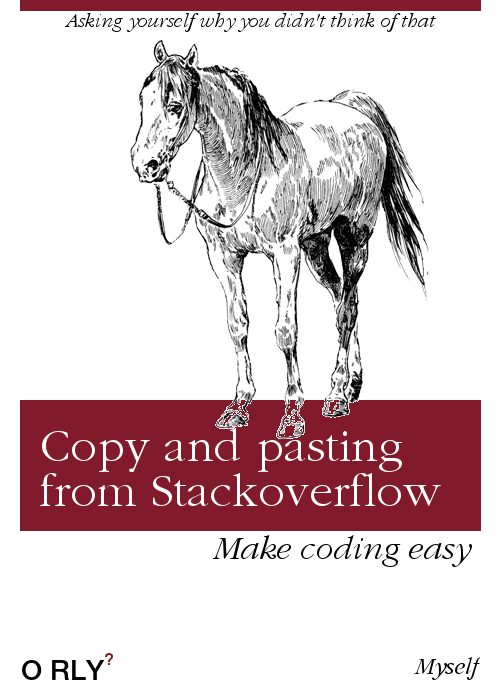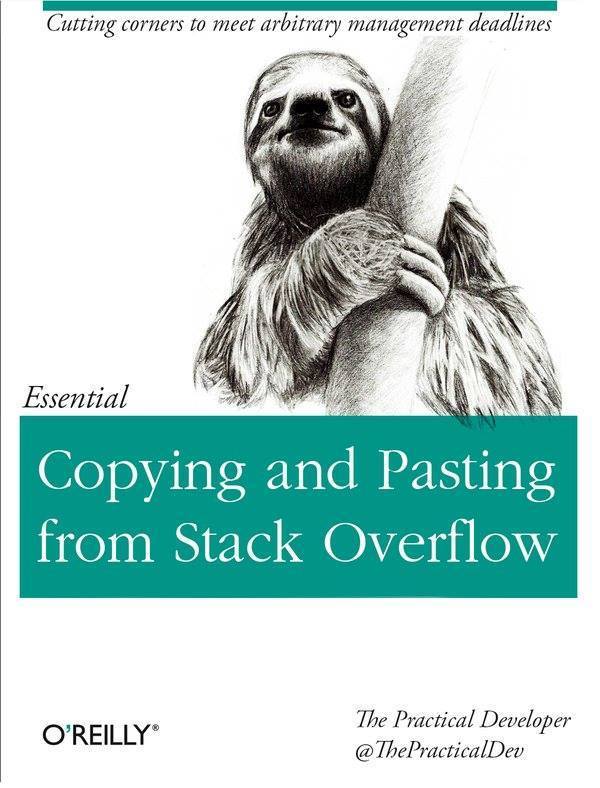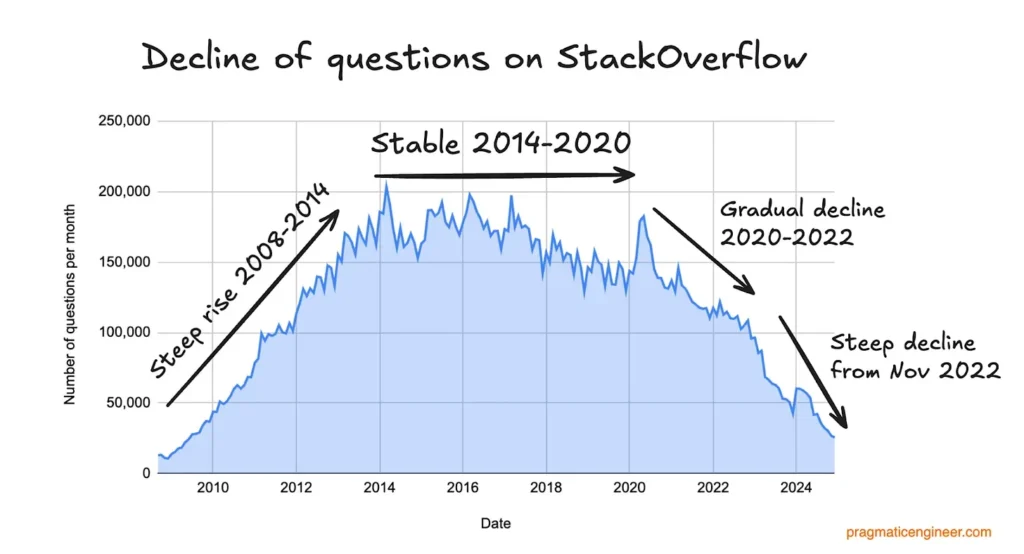At RocketEdge.com, we pride ourselves on staying at the forefront of cutting-edge software practices and technologies.
Today, developers report they spend an average of just one hour per day coding. They spend most of their time on tedious, undifferentiated tasks such as learning codebases, writing and reviewing documentation, testing, managing deployments, troubleshooting issues or finding and fixing vulnerabilities.
-Source AWS (Dec 2024)
While some companies, such as Amazon, struggle with outdated workflows, our teams have embraced the power of generative AI, automated tooling, and a high-experimentation mindset. We believe this new approach not only boosts productivity but also revolutionizes how we think about costs, maintenance, and overall system design.
The Game-Changer: LLMs and ChatGPT
Until 2022, building software meant browsing scattered documentation, copying snippets from StackOverflow, and stitching together best-guess solutions on the public cloud—often with little concern for the real costs of architecture choices.


Then, in November 2022, OpenAI’s ChatGPT entered the scene and profoundly reshaped the software world. Almost overnight, the need to continuously scour StackOverflow for code examples dropped dramatically. Tasks that once took hours of reading forum posts and outdated docs could suddenly be synthesized into coherent solutions by ChatGPT. This shift sparked conversations about the relevancy of legacy Q&A forums, as The Pragmatic Engineer noted, and ushered in a new era of software productivity.

A New Philosophy of Development
At RocketEdge.com, we’ve embraced a philosophy that fundamentally differs from the old norms:
- Step-by-Step Workflows Are Automated
The repetitive pieces of development—like writing boilerplate code, searching for typical bug fixes, or implementing standard patterns—are now almost entirely handled by LLMs. This frees engineers to invest their mental energy in more valuable endeavors: system architecture, cost optimization, and user-centric design. - Value Through Experimentation
Because boilerplate tasks are automated, teams can try multiple approaches rapidly. The principle of wide experimentation means we don’t just pick one path and go with it; we consider various technologies, run real-world tests, and rely on data-driven decisions to find outliers or anomalies that might unlock innovative breakthroughs. - Cost-Effectiveness Reigns Supreme
Today’s software engineers must consider not just the expense of compute, but also human time, long-term maintenance, and the potential overhead of building everything in-house. We emphasize reusing third-party APIs and services where it makes economic sense. The best code often ends up being the code you don’t write. Minimizing in-house development can significantly reduce bugs, speed up deployment, and keep your focus on delivering core functionality.
Our Modern Toolkit
We utilize several robust AI-driven tools that power our workflow:
- ChatGPT o1 for Python and C#
We’ve found that this specific model consistently outperforms others in generating high-quality Python and C# solutions. - Perplexity.ai
Ideal for research and exploring an uncharted problem space. When we need a quick understanding or a multi-perspective analysis on a topic, Perplexity.ai provides it. - JetBrains AI Plug-in
Integrates into PyCharm and Visual Studio to offer real-time code suggestions, unit test generation, and partial refactoring. - GitHub Copilot
Works alongside JetBrains AI to continually suggest lines of code or entire functions, helping to maintain the developer’s flow.
These tools, when used correctly, are a force multiplier. They allow us to generate and iterate on code quickly, weaving AI into every step of the software lifecycle.
Expanded Best Practices for Modern Development
Through extensive hands-on experience, we’ve curated a set of principles and best practices that guide our daily work. Here are the core insights—now with additional detail and reasoning:
- Mindset is the Ultimate Differentiator
- Curiosity ensures you keep learning about new techniques and tools.
- Critical Thinking helps you distinguish which solutions might work in practice.
- Strategic Decision-Making means aligning technical choices with business goals.
- Empathy fosters healthier collaboration and a stronger focus on end-user needs.
- Refine Your Judgment Constantly
- It’s easy to let AI generate code, but you need the intuition to evaluate whether that code is appropriate, optimal, or even secure.
- Develop an internal “map” of potential pitfalls to avoid them before they appear.
- Stay Informed of Trends
- Modern development is fast. Techniques and libraries from even a year ago can be replaced or upgraded.
- Rely on AI tools like Perplexity.ai or ChatGPT to quickly go from a broad overview to deep detail when you need it.
- Focus on Architecture & Wisdom
- AI excels at generating modules or performing micro-optimizations, but it can’t define the big picture: how systems interconnect, where potential scalability issues might lie, and which trade-offs are tolerable in your specific context.
- Embrace Pragmatic, Established Processes
- Version Control (Git) and Project Management (e.g., JIRA) create a safety net in your iterative cycles.
- With so many experiments and branching ideas, you must stay organized to track each solution’s outcome.
- High-Quality Prompts, High-Quality Code
- Don’t expect perfect AI-generated code from a vague statement. Spell out your data models, architectural constraints, error-handling requirements, performance targets, and more.
- The more exhaustive your prompt, the closer you’ll get to a robust solution on the first pass.
- Incremental Overhaul vs. Complete Rewrite
- When dealing with an existing codebase, be cautious about letting AI rewrite entire modules unless you’re sure it preserves all legacy functionality.
- We often ask AI to create new functions or components, rather than revise the entire project at once—this keeps us from accidentally introducing new bugs.
- Code Variability & Validation
- Large Language Models often generate code differently in each run. Always review what’s produced and confirm it aligns with your specifications.
- Anticipate Data Cut-Offs
- LLMs often run on training data that may be up to two years old. If you rely on brand-new frameworks or language features, validate them manually or provide ample documentation in your prompt.
- Scenarios Where GenAI Shines
- Boilerplate Automation: LLMs handle standard, repeatable processes (e.g., data pipelines, file parsing, automated reporting).
- Prototyping Multiple Approaches: Rapidly ask for five or more different solutions, then compare them.
- Debugging & QA: AI can identify suspicious lines of code or potential vulnerabilities faster than manual reviews.
- Unit Test Generation: Outline your test scenarios, and let AI build your test suites.
- Evidence-Driven Choice of Solutions
- Don’t rely on “gut instinct” alone. Use logs, metrics, test coverage reports, and user feedback to pick the best approach from AI’s multiple suggestions.
- Optimize for Outliers & Anomalies
- Innovation often hides in the unexpected. Seek anomalies in performance or usage data—these can highlight future breakthroughs or crucial design refinements.
- Aim for Minimal Code Footprints
- Each additional line of custom code you write is a potential point of failure and a maintenance cost. If a well-maintained open-source or third-party solution exists, strongly consider it.
- Prompt Crafting Is a Skill
- Writing effective prompts is half the battle. Understand how to “speak AI” to get the results you want—this is a new kind of literacy in software development.
- Leverage AI for Commodity Work, Focus on Uniqueness
- For typical tasks (logging, user management, standard data transformations), let AI handle the code generation.
- Preserve your human focus for the tricky business logic or unique selling points that differentiate your product in the market.
Why It Matters and Where We’re Headed
This new mode of development matters because it redefines productivity. By delegating the tedious, repetitive tasks to AI, human developers can concentrate on:
- High-level creativity: designing architectures that are scalable, secure, and elegantly solve user problems.
- Strategic budgeting: ensuring cost-efficiency in both compute and developer time, and proactively avoiding technical debt.
- Empathetic design: seeing the user’s challenges more clearly and building solutions that resonate with real-world use cases.
The days of frantic Googling and duct-taping solutions are behind us. We’re moving toward an era where collaboration between AI and humans is the norm, where code is often generated or refactored automatically, and where engineers primarily guide the vision and architecture. If your team is still mired in manual procedures, repetitive tasks, or bloated codebases, it’s time to join the modern wave of ultra-effective software development.
Ready to supercharge your development process?
Visit my blog or explore RocketEdge.com to discover more insights and get a glimpse of how we’re shaping the future of software. Embrace AI and become the architect of a development practice that is agile, cost-conscious, and poised for breakthrough innovations.
